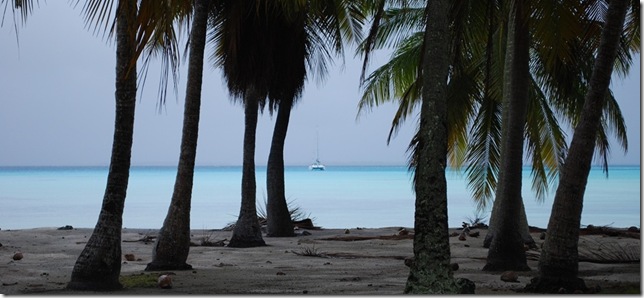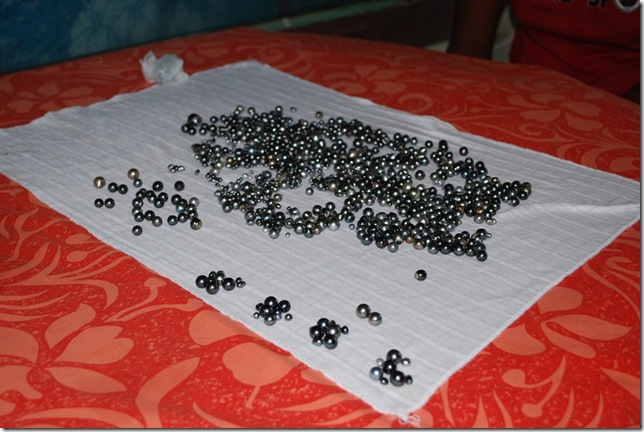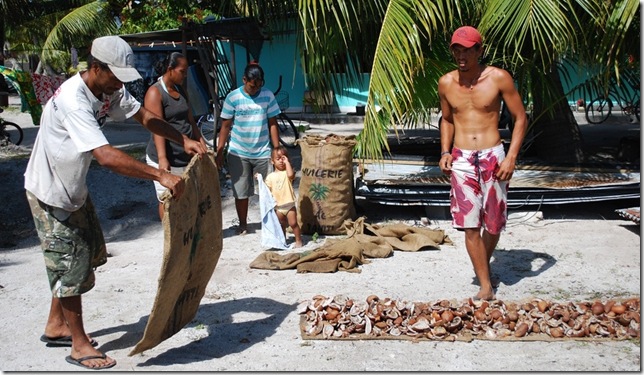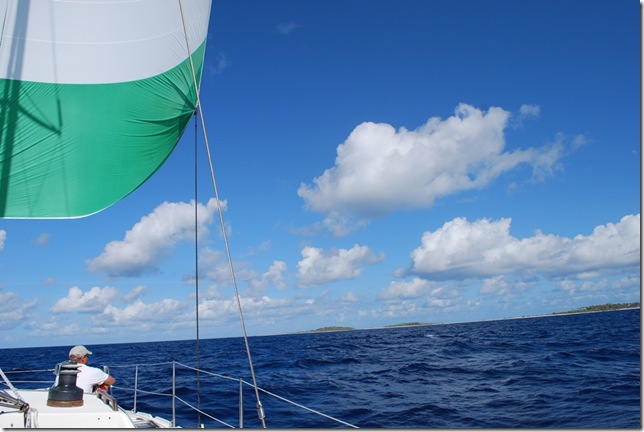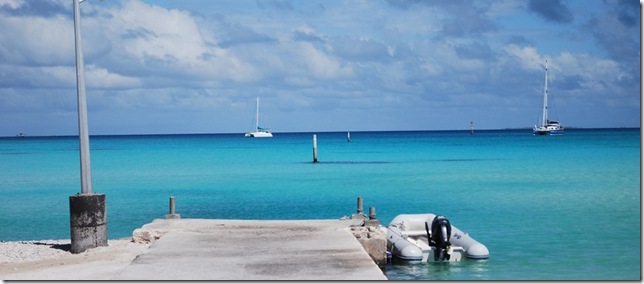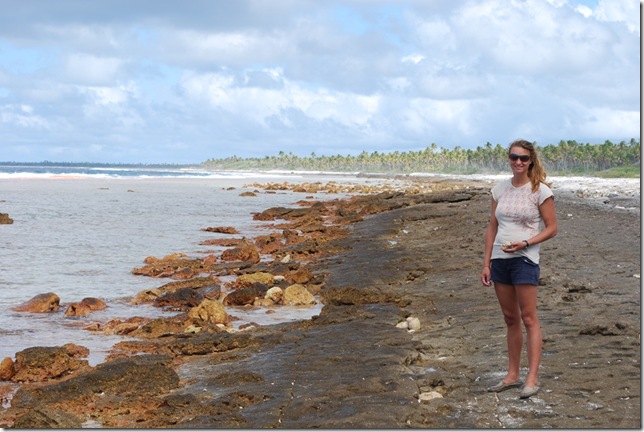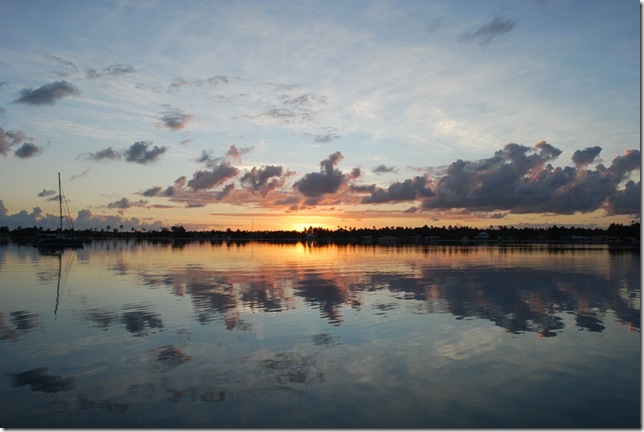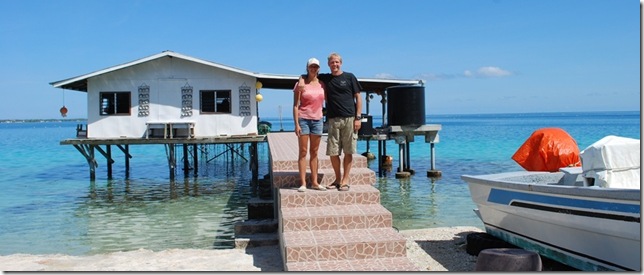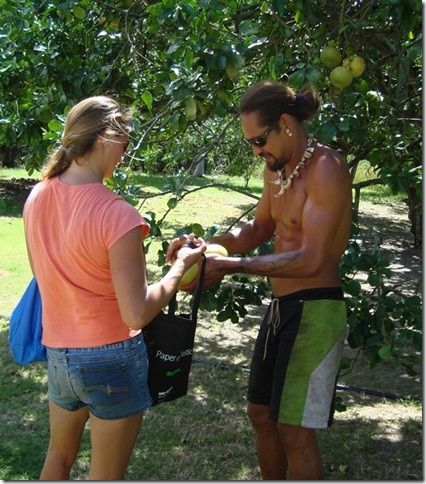The rain and wind continued, with the wind forecast to increase, so we decided to stay put for a day or two.
We made it into town just in time to see the pilgrimage/procession yesterday. Jeahu and Jimmy and the local policeman went ahead to clear the way and act as security, but the town was empty except for the people in the procession, wandering dogs, and crabs. The centerpiece of the procession was a Virgin Mary on a pedestal that was carried on a litter formed by two long, yellow canoe hulls. There were so many flowers and coconut palm weavings on the litter that I didn’t notice the small statue of Mary until about halfway through. They started at one end of town proceeded along the street, alternating between singing and saying a sort of chant. They stopped several times at pre-determined spots, where the double canoe was set on a table and there was a short sermon with more singing. Rain drizzled occasionally throughout the procession, but umbrellas appeared for some, with the less involved and young children taking cover under coconut trees or the awnings of nearby houses. All of the men involved in the ceremonies wore plain white robes, except for the bishop, who had gold trim and a special design on the front of his robe.
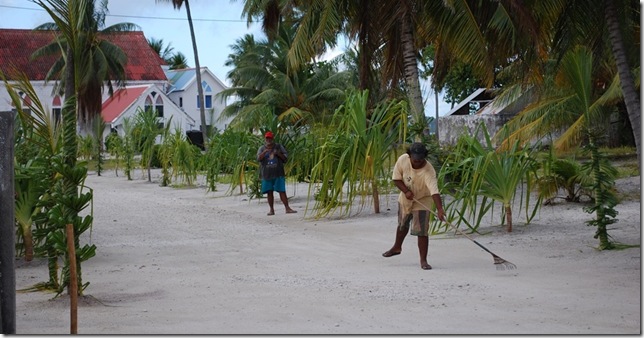 Raking the gravel road the day before the procession
Raking the gravel road the day before the procession
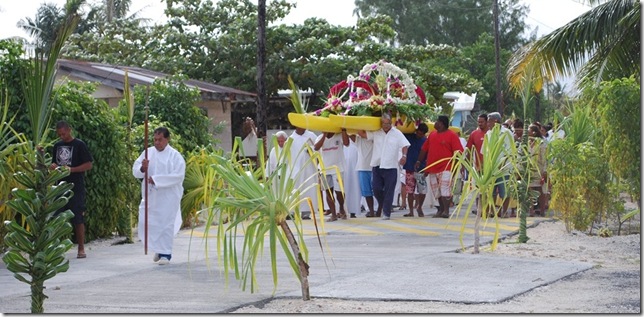 The procession getting underway
The procession getting underway
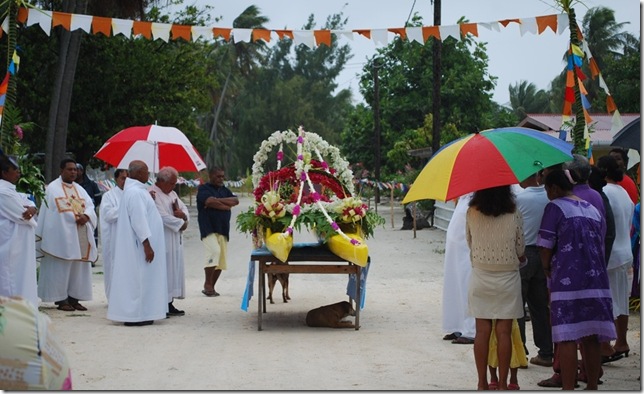 A dog catches some relief from the rain under the canoe during one of the stops
A dog catches some relief from the rain under the canoe during one of the stops
There were about 60 people at the gathering at the end of the road where the main street in town abruptly turns into a small beach at the edge of the lagoon. They had set up a shelter for the speakers and canoe and there were old plastic chairs from the city of Fakarava for people to sit in. We stayed for most of the service, including a sermon by the bishop and plenty of singing before leaving to make it back to the boat before dark.
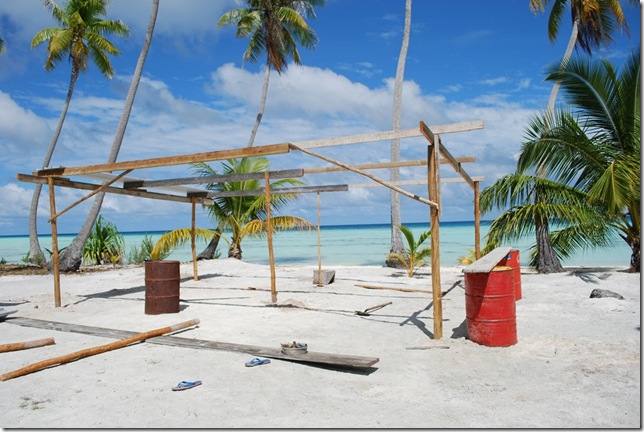 Makeshift chapel at the end of the road just starting construction
Makeshift chapel at the end of the road just starting construction
It was a pretty site for a service, at the edge of the lagoon with the wind blowing through the coconut trees and whipping up whitecaps on the turquoise water of the lagoon. As we’ve been told, their singing was amazing. They typically sang acapella in four part harmony, though there was guitar and ukulele accompaniment during part of the service. Much of the ceremony was in the local language, but parts were done in French as well, so we were able to pick up a little bit of what they were saying.
We’ve had several firsts here in Kauehi over the last couple of days. Right after writing the last blog, I learned that Wes had caught the first fish. He used Jimmy’s technique of feeding them first and then putting a hook in a piece of food. A banana from Nuku Hiva was the bait that landed the first fish, an aggressive one a little over 2 feet long that had been swimming around the boat with others. It didn’t look like good eating, and we’re not even sure what it was. It sort of looked like a baby shark but had a head that was flat on top with an area that looked like the tread of a tennis shoe.
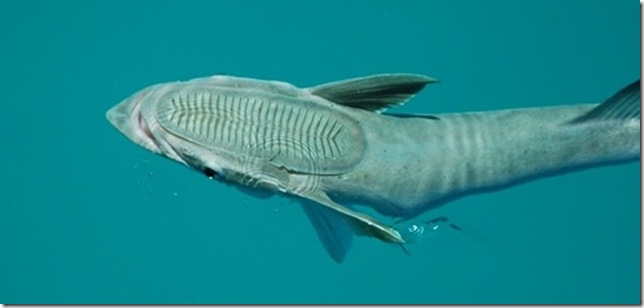 It’s an odd one and it likes bananas
It’s an odd one and it likes bananas
After several missed appointments with the pearl farm owner, we finally asked around and got our first look at some black pearls that one of the locals who works on a pearl farm was selling. Although the pearls you see on the typical necklace are pretty uniform, black pearls in general are anything but homogenous. The colors included silver, gray, green purple, white, and an iridescent color that looked sort of like the different colors that a sheen of oil makes when it’s sitting on top of water. There were of course a few very spherical pearls, but nearly all of the perfect ones go to Tahiti, so the collection we looked at included a wide variety of shapes. Some were sort of lumpy sphere, some just had a small imperfection, some were sort of teardrop-shaped, some looked sort of like spinning tops, and some had cylindrical features. There were also a lot of what were called "kee-shee", which were tiny pearls of many different colors that were shaped a lot like Pop Rocks candy. We picked a few we liked and headed to one of the other boats in the anchorage for a drinks and food.
There were several firsts aboard Na Maka as well. It was the first time we’d visited a French boat, which is one of three anchored here now. Jerome, his wife Natalie, and their three boys (9 and 3-year old twins) are on a Switch 51, which is a beautiful new catamaran equivalent in cost to a small fleet of Pura Vidas. We weren’t sure what to make of them based on our brief conversations from the dinghy, but they turned out to be incredibly nice, very gracious hosts, and informative as well. They’ve spent a lot of time in many different parts of French Polynesia and gave us some good tips on the various places we haven’t visited yet. Jerome also made a really great emerald drink with blue curacao that was, as he put it, "the color of the lagoon." Tiff gave good reviews to her first taste of the giant clams, served with only lime juice, that are common here. We saw purple and blue ones while diving, and apparently they’re several other colors as well..
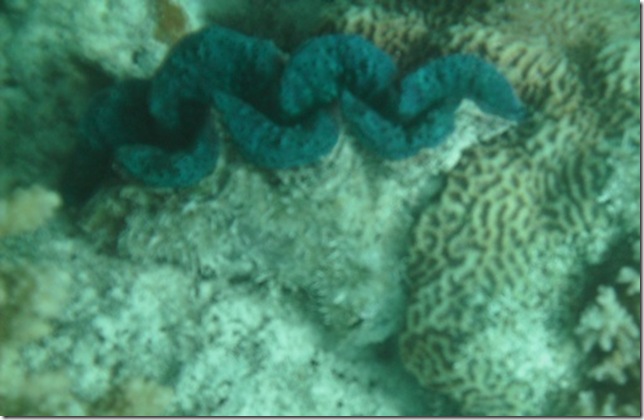 We left this blue giant clam on the coral head
We left this blue giant clam on the coral head
Without us mentioning the random store hours and impossibility of someone keeping an appointment to look at pearls, Natalie and Jerome brought up the local concept of time, which is basically summed up in 3 words — yesterday, today, and tomorrow. Anything that happened in the past naturally happened yesterday, and tomorrow could mean several days or even a month or more. Life is lived for today, and making an appointment for three days from now is the same as saying "we should go fishing together sometime." The inter-island trading boats and Air Tahiti planes are about the only things that seem to keep anything resembling a regular schedule.
A large yellow catamaran named Banana Split had just anchored between us that was single-handed by a man with long graying hair and a full beard that looked not a little like Chong (of Cheech and Chong fame). We thought for sure he must be American, especially when he spoke perfect English, but it turned out he was a Frenchman as well. He was aboard Na Maka when we arrived, so we were introduced to Antoine, who was the first French celebrity we’d chatted with. It turns out he was a famous pop star/idol in the 60’s ("World-famous in France only", he chuckled) that Jerome told us was still well-known by millions. He gave up the pop star life for sailing when he was 30 and a planned 5-6 years of sailing has turned into 34 (including spending most of 2 years in the San Blas islands of eastern Panama after leaving the Galapagos heading West, then turning around after a few days when heading West didn’t feel right). Along the way he’s made 25 documentary films (antoine.tv), mostly travelogues, and written well-known sailing books. Jerome showed us a couple of the books, one of which is considered the French "cruising bible", covering all aspects of offshore sailing and living aboard. Antoine was also an incredibly nice guy, and it’s turns out he’s been here in the Kauehi lagoon for a couple of days anchored in the more remote reaches. Although he’s a very amiable guy, crowds of people aren’t his thing, and he spends most of his time in French Polynesia among the three least-visited archipelagos (Gambier, Australs, and Tuamotus). Visiting the lesser-frequented areas seemed to be a common denominator among all of us and probably explains why we’re the only boats here in Kauehi.
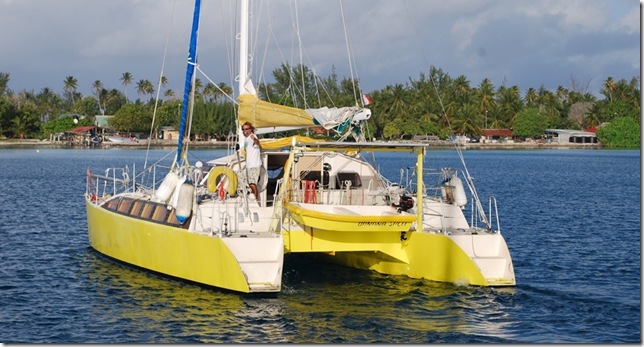 Our friend Antoine on Banana Split
Our friend Antoine on Banana Split
The wind had picked up while we were talking and it was starting to sprinkle, so it was time to go. By the time we got back to the boat, we were all soaked. In addition to rain, the lagoon was choppy enough that we were taking a on a fair amount of seawater over the bow of the dinghy even with the engine at idle speed. Last night was the first real rainstorm we’ve seen in the Pacific. Panama had its afternoon showers, the ITCZ had small scattered squalls, and the Marquesas had a few drizzly hours when the mountains pulled the moisture from the tradewinds, but this was the first actual rainstorm. It rained most of the night and into today, with strong winds from the SSE.
At breakfast, we talked over our itinerary from here to New Zealand and realized once again that the Pacific is a big ocean, with much more to see than we have time for. Fakarava will be our next stop. We’ll probably head there later today or early in the morning if the winds aren’t too bad. We’d like to transit both atoll passes in daylight if possible, and the rainy weather has put a bit of a damper on our plans to photograph the pilgrimage march and city-wide celebration marking the bishop’s visit.
At dawn Wednesday morning, Wes and Tiff could clearly see Kauehi. The Kauehi lagoon is approximately 12 miles by 8 miles and as we approached it from the east, we could see the low shoreline, trees, and breaks between the islets where the pounding surf threw spray high up into the air. Before the days of GPS, this was known as the "dangerous archipelago," as the inaccuracy of existing charts, uncertainty inherent in celestial navigation, and swift, changing ocean currents made attempting to navigate through the Tuamotus very dangerous. Many boats skipped the chain altogether in the interest of safety.
As we sailed along less than a mile from the south coast, we re-rigged the spinnaker to fly on the port side of the boat (the rolling hitch is an indispensable knot for re-running sheets with the sail up), then doused the spinnaker and unfurled the jib as we worked our way north along the west side of the island toward the pass on the west edge of the lagoon. We approached the pass with both engines at cruising throttle but still had an interesting time, even though this is one of the easier passes in the archipelago. The water depth changes from 100-175 feet inside the lagoon, to 30-40 feet in the pass. At the outer edge of the pass, where the water depth drops to 60 feet in less than a tenth of a mile, we were met with an outgoing tidal current and a sea surface that looked like it was boiling. Nearing the edge of the pass, we motored over a strong whirlpool about 10 feet across that spun the boat to port as we passed over the it. I took the wheel so Wes could try fishing through the pass, and we slowly made our way through against a current that peaked at about 3.5-4 knots.
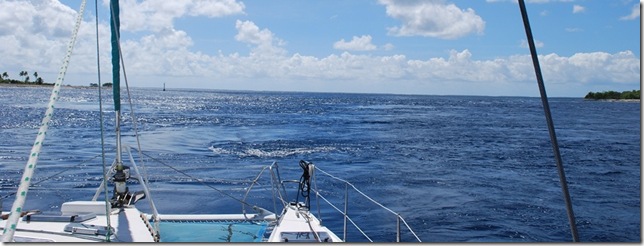 Check out the whirlpool we’re about to motor over
Check out the whirlpool we’re about to motor over
After motoring into the wind for a couple of hours to cross the lagoon, we anchored near the village at the east edge in beautiful turquoise water with coral heads clearly visible nearby. The beauty of the setting had us all captivated for several minutes, but Wes quickly started preparing the dinghy for a trip to shore to see the village and procure our first cold beverages in a week or so. The sleepy village of 300 seemed to be virtually abandoned except for the children playing on the dock and around town. The first store we stopped at was closed in the middle of their posted business hours, which isn’t unusual around here (the post office only posted to be open two hours every morning) so we kept walking. We finally spotted someone who confirmed that there was another store in town and gave us directions. Despite undoubtedly passing within 75 feet of it, we didn’t recognize it and it clearly wasn’t open, so we retraced our steps, on the one main road through town and made more inquiries. Several people agreed that the store would indeed open in the evening, but they guessed it would be sometime between 4pm and 6pm. Great.
 View of “Kauehi City” from the anchorage
View of “Kauehi City” from the anchorage
To kill some time, we made the short walk across the island to the eastern shore. Almost everywhere on the island are coconut crab burrows that the crabs scurry into as you walk by. Aside from the coconut trees, there’s not a lot in the way of grass or brush growing on the island. Ground up coral covers the ground everywhere, and it’s only with a lot watering that the bushes in some of the yards are kept alive. There are apparently no wells or desalinization plants here, so everyone’s roof is a large rain-catching system with the gutters leading into large black plastic tanks sitting in the yard. The eastern shore was nothing like we’d expected. Instead of a soft sandy beach, we found huge slabs of coral rock bordering an area of shallow, clear water that extended out a couple of hundred feet before it dropped away into blue ocean where the breakers pounded away into rose-colored coral rock. Apparently there’s a vibrant reef out there, as the shore was covered in pieces of bleached coral broken off by the pounding waves and washed up with the tide.
Tired, thirsty, and hungry, we finally sat down in front of the the store, and began to wait. Wes looked through the window grates and read off what he saw — cold cans of Hinano, frozen store bread, baguettes, canned food, ice cream, chips, etc. all locked inside. We were about to give up at 5 minutes till 6 when a woman walked up and told us the store would be opening in a few minutes.
When her husband, a former police officer in Tahiti, drove up, he opened the store and we enjoyed a delicious cold fruit tart, baguette, and tall Hinano while we chatted. In addition to being a retired police officer, Jeahu is also the town mayor, store owner, pearl farmer, and family pension (motel) owner. He was friendly, often working, and had a tattoo on each shoulder. His hair, which was buzzed very short, was only in a circle about 5 inches across on the top of his head. He agreed to give us pearl farm tour, including lunch, for only about $6.25 each! We’d wanted to tour a pearl farm and the price was ridiculously low for here, so we agreed to meet back at the store at 9am.
Dawn this morning found the lagoon almost like glass, with hardly any wind at all (it was actually so calm and quiet that none of us slept very well). It was really an incredible sight to see the colorful clouds reflected in the tranquil water of the lagoon as the sun started to find its way above the coconut trees on the shore. Things weren’t ready to go at 9am, so we sat around the store and chatted with a guy named Jimmy, who’s staying for a while at Jeahu’s pension and is an expert fisherman. He told us that even though the people of the Tuamotus are surrounded by fish, most of them just come to the store to buy canned fish instead of going out and catching it. He showed us pictures of the fish he’d caught the day before at the edge of the eastern reef, and they were pretty impressive.
Jimmy spoke some English, and he accompanied us as we jumped into the back of Jeahu’s truck and headed for the pearl farm. The water was so clear under the pearl station that we enjoyed a great view of the reef fish on the nearby coral heads without even having to get wet. A 4-5 ft black-tip shark glided by. Several trumpet fish up to 4-5 ft long were hanging out under the structure, and a massive eel about 4 feet long and a foot tall darted from one coral head to another. Lots of smaller colorful reef fish darted around, and Jimmy pointed out several big, heavy fish that look a lot like grouper and are called "koti" here. They’re evidently pretty tasty, and he put on a fish-feeding show for us by bringing over three large, live hermit crabs that had been taken out of their shell then tearing them into pieces and tossing them in the water.
With a fair amount of effort, Jeahu and Jimmy were able to explain the basics of pearl farming to us, though some of it is still a little murky. It’s apparently quite a lot of work. The oysters are seeded with a marble-type object (made from mother-of-pearl powder) that is grafted in by a skilled worker. After about a year and a half, the first pearl is formed around it and removed. A new, larger marble is put in and the process is repeated up to 4 times, with the later pearls forming faster. The oysters are attached to a rope, and hung at an optimum depth of 6 meters or so. The oysters feed on plankton, and every couple of months, they have to have their shells cleaned off. Jimmy told us that Jeahu had about 200,000 oysters spread out over the area of the lagoon we were looking at. There were definitely a lot of buoys, and when we swam out to one to check out the oysters, his estimate seemed reasonable. The visible buoys anchored lines dropping down into the water. Between buoys, a horizontal line was run at the optimum depth, where line after line full of oysters was hanging down and covered by a mesh bag. The quality and color of the pearls is a function of the water quality, water temperature, and sunlight reaching the oysters. Here, the pearls are called "black pearls", though they’re several different colors and shapes (we get to see some tomorrow). It’s all a pretty impressive operation.
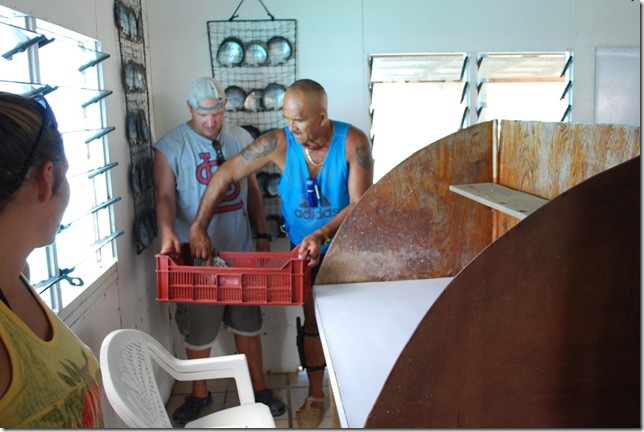 Jeahu explaining the pearl production process
Jeahu explaining the pearl production process
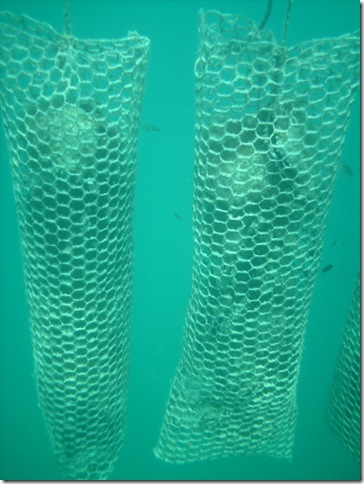 Oysters hanging from a line placed at just the right depth
Oysters hanging from a line placed at just the right depth
While lunch was being prepared, we chatted with Jeahu and Jimmy, who shared a funny story. Everyone on this island is Catholic (there’s a big celebration on Saturday when the 11-island bishop visits), but Jimmy is a Mormon. When some Mormons from the US came to visit and do their mission work, he fed them dog without telling them what it was. When he clued them in afterwards, they all got sick but ended up asking for it repeatedly after that. It’s worth noting that when Oceania was populated by the Polynesians, they only had three domesticated animals to bring with them — pigs, chickens, and dogs. Not all islands ended up with all three animals, but with at most three choices for red meat, dogs were enjoyed everywhere they were found.
It’s also worth mentioning that all four had previously read of the rough life of atoll dogs in the book "Sex Lives of Cannibals" that Lauren’s friend Brenna had recommended. It tells the story of an American couple who recently lived for a couple of years on the island of Tarawa in the Pacific nation of Kiribati. It gives a pretty funny and candid account of what life on a small atoll in the middle of the Pacific can be like. We all had a good laugh and felt a little more informed about atoll existence in general.
Lunch was ipo (EE-po), which is like a starchy coconut pattie eaten with coconut milk, Jimmy’s catch from yesterday prepared two different ways, and rice. It all received rave reviews, and then we piled back into the truck to head back to the boat for a nap and bottom-cleaning (boat bottom/hull).
Several of the locals have referred to this place as paradise, and it is incredibly beautiful and peaceful. The slow pace of life, the beautiful blue ocean and turquoise lagoon, and the small village where you can know everyone is a different world. Jimmy and Jeahu have both come here (to paradise) to get a way from the hustle and bustle (action / hell as they say) of Tahiti. It really is one of those places where the days blend into each other and the industrial world seems like more of a memory than a reality.
Lat: 15 29.856′ S
Lon: 144 29.348′ W
The last few days have been some of the calmest sailing we’ve seen yet. The winds are light, so our speed hasn’t been great, but there’s hardly a whitecap in sight, and the days are sunny and beautiful. The wind has slowly clocked toward the northeast a bit, so we’re using a spinnaker to run downwind. The spinnaker we usually fly has a tear in a trim piece, so we’re using our other spinnaker, which is green and white. It’s a bit smaller and slightly asymmetrical (an intentional design feature to make it easier to fly when not going straight downwind), but is staying set pretty well in the light wind.
On the negative side, the main halyard chafed through again. This time the 1/4″ stainless steel wire rope I spliced in at the end of the halyard actually chafed through! It was still running through a block outside the mast, which doesn’t look like it’s going to be a feasible approach. Hopefully in Tahiti I can get a longer piece of wire, splice it back into the halyard, and try it again. There’s got to be some solution that will work.
With such calm seas, there wasn’t much adjusting to do, so we’re all pretty well settled in. New Zealand radio comes in pretty well, so we’ve been able to listen to news shows, which we’ve appreciated. There was a news piece on today about a Kiwi member of parliment who’s caught a bit of heat from the press for having the most travel expenditures ($67k NZ year-to-date). He’s promised to get around by hitchhiking for a while to cut costs and get to know his constituents better. That’s good stuff. Lauren and I have been spending some time with a sudoku book that she found in Panama (the Spanish-language crossword puzzle books weren’t going to work), and we’ve all enjoyed making a passage with less motion than some of the anchorages we’ve been in.
Aside from the usual reading, I’ve been able to start some work on the boat as well (yeah, I am actually a little bored). We haven’t ever had a working knotmeter (speedometer), but we have a spare on the boat, so I took a look at things. The GPS can tell us what our speed over ground is, but without a knotmeter (which gives your speed through the water), we don’t know the strength of the current, which can be nice at times. The previous owner said the transducer just needed a new impeller, but in typical fashion (a) that wasn’t true at all, the transducer was shot, and (b) the transducer wasn’t even connected to the display. I looked into a new transducer before we left, but everyone standardized on through-hull diameter at some point since ours was initially installed and the size they chose was a bit larger in diameter (and our old version is long since obsolete), so to put a new one in we’d have to put in a larger through-hull (make the hole in the boat bigger) — not really do-able while you’re on the move. Luckily, although it’s a slightly different design, the spare is the correct diameter and doesn’t seem to leak when it’s installed. Even though it doesn’t have any documentation, I was able to figure out the wiring and it looks like we should have a knotmeter and water temp sensor later today.
It looks like we’re going to try stopping at two of the Tuamotus — Kauehi and Fakarava. The Tuamotus are a string of atolls running northwest-to-southeast between the Marquesas and Tahiti. While the Marquesas are relatively young and high volcanic islands with only one bay having a coral reef, the Tuamotus are old volcanic remnants — the peak of the volcano has sunk back into the sea and all that’s left is the fringing barrier reef, which is present in the form of small coral islets (motus) of shallow reefs that mark where the barrier reef of the old island used to be. In between the newer Marquesas-style high island with no reef and the atoll are most of the Society islands, including Tahiti and Bora Bora, which have a high island surrounded by a fringing reef that creates an encircling lagoon. The atolls are all lagoon, and when the tide goes out, almost all of it runs through the one or two small passes into the lagoon. Imagine the water level in 50-200 square miles of lagoon dropping by several feet over the course of 6 hours or so and all having to run through a couple of small passes — the current in the smaller passes can exceed our cruising speed of 6 knots under power! In order to avoid having to time the tide and associated current, we’re going to try stopping at a couple of atolls with larger passes. We are hoping to be able to dive one of the passes, as watching the marine life funnel in and out is supposed to be amazing. We may also get our first encounter with sharks as well — the slogan of the dive shop on Fakarava is “every dive without a shark is free.”
The nights have been beautiful as well. The moon is starting to wane, but is still so bright that you can easily read during your watch by moonlight; it hurts your eyes to look directly at it. We’ve seen a few ships, which is a change from the Galapagos-Marquesas crossing, where the signs of mankind totaled one loose orange buoy and one floating pair of pink underwear in 22 days.
Lauren’s mourning our dwindling list of ingredients for meals, but we’re still eating pretty well. A couple of days ago I opened a coconut and we had fresh coconut and homemade granola with powdered milk for breakfast. Last night we enjoyed homemade pizza, although the funny no-refrigeration cheese doesn’t melt too well (I guess whatever French word gets translated as fondue doesn’t really mean melting cheese). We have potatoes and eggs from Nuku Hiva, so Wes & Tiff made a traditional scrambled eggs & potatoes breakfast this morning. Pasta & sauce or rice & something shows up every day or two, and when we’re near a store here in French Polynesia, there’s always baguette with cheese and cucumber or tomato.
This afternoon, Lauren spotted a spinnaker behind us on her watch, and minutes later a call for “the sailboat flying a green spinnaker” came up on channel 16. We answered and had a nice chat with a Kiwi boat called “Alpha Cruces” (after the brightest star in the southern cross) that’s been out sailing for 4 years. They left the Galapagos headed straight for Tahiti — we were the first boat they’d seen in 23 days. Like other Kiwis we’ve talked to that have been around the world, seen most of the Pacific, and are finally headed home, they’re biting off some long Pacific passages to get home soon. In all our travels, we have yet to hear a bad report on New Zealand, so we’re really looking experiencing it ourselves.
12 19.000′ S
142 19.075′ W
We have returned to the quiet and solitude of the Pacific tradewind belt. Our last couple of days in the Marquesas seem quite busy by comparison. As Dallas described, the hike to the waterfall at Daniel’s Bay was magnificent. What’s more, swimming in the cold (but somehow still comfortable), crystal-clear freshwater pool, nearly surrounded on all sides by immense volcanic rock, ranks near the top of our list of things to do in the Marquesas.
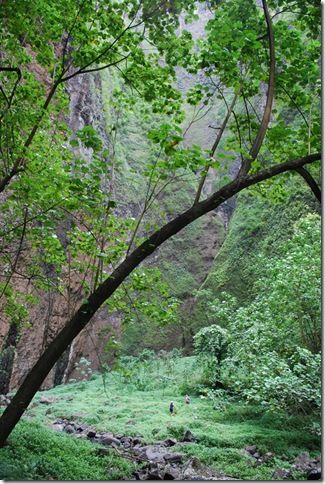 Verdant canyon near the waterfall
Verdant canyon near the waterfall
Shortly after we arrived at the waterfall, we were joined by a cruising couple aboard S/V Alethia Ann who we had never met but quickly befriended. We invited them aboard for a drink on Wednesday night and found them to be delightful company. Like Dallas and I, they are happy newlyweds, but unlike us, they come from different places and times. She is a young and exuberant retail clerk from Thailand, while he is an older English ex-pat who was a pilot for many years. In addition to building two houses in the Caribbean, he built their boat (which took longer), an unusual square-rigged, 48′ monohull that he has sailed across the Atlantic three times. Their boat only sails at 3 or 4 knots top speed due to its heavy load, so they had allotted 6 weeks for the Galapagos-to-Marquesas passage! Fortunately, it only took them 29 days. Let’s hope that they have similar luck throughout the Pacific, as they are making a beeline to north Australia in an effort to beat the cyclone season. Provided the Somali pirate situation improves (allowing us to stick with our original route), we will see them again at their new home in Thailand.
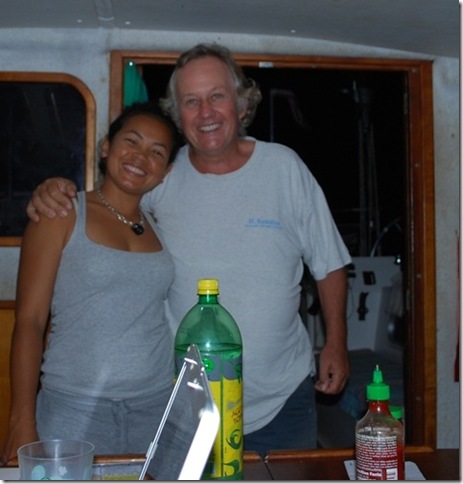 Pek and Barry aboard Pura Vida
Pek and Barry aboard Pura Vida
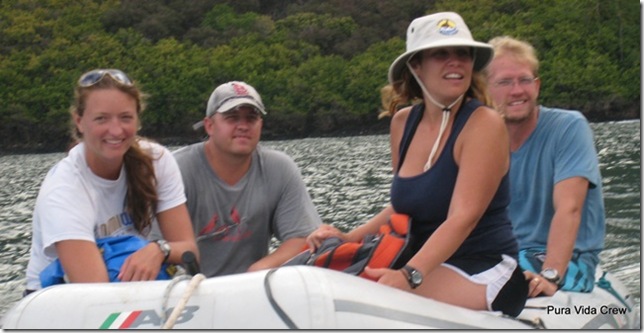 Getting a tow back to the boat from Pek and Barry
Getting a tow back to the boat from Pek and Barry
I think we all could have spent several days in Daniel’s Bay enjoying the pool as well as the verdant feast-for-the-eyes offered by the surrounding cliffs and forest trail, but we, too, have to watch the calendar. As it turned out, we spent an extra night there, but it was out of necessity, as Dallas attempted to use the generator to equalize the house batteries. This, I am told, was long overdue in that their capacity was greatly depleted, but since we have been spoiling ourselves with the use of computers, stereo, fans, etc., it took the entire day just to bring the batteries back to baseline. By the time we were in super-charge mode, there was less than an hour left before neighbors would have been heading to bed, not long enough to have much of an effect on our overall capacity, so I’m sure we will be trying again soon.
While Dallas dealt with the electrical system, Wes, Tiff, and I jumped in the dinghy (using the outboard motor this time) and headed back to the adjacent bay to fill our jugs with the "best water in the world" and take our meager offering to the woman that had loaded us up with fruit the day before. Tiff and I went to see her while Wes got started filling water. First I showed her the baguette that I had brought despite that it represented a good part of our limited bread supply for the passage to the Tuamotus. Immediately she rejected it. I had better luck with a large jar of jelly (purchased in Panama), but that’s when things kind of stalled out. She accepted a men’s t-shirt, a package of unopened duct tape, and a new can of WD-40, but it was clear that she was not impressed with any of these items. Admittedly, we got the better end of the deal, but we simply did not have the cigarettes and jewelry ("no small earrings, big ones!") that she desired.
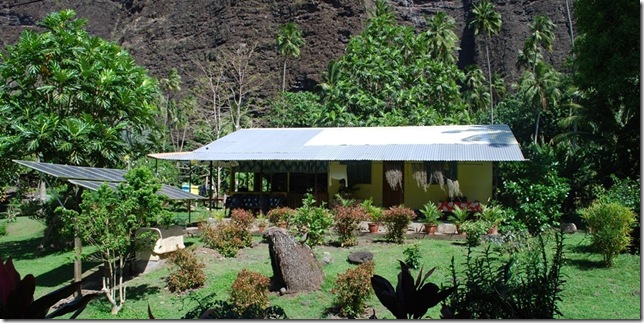 The home of Monette, the professional barterer
The home of Monette, the professional barterer
It was pretty evident that we needed to be trading with someone more likely to identify with our financial situation (i.e., poor). We found him on the beach of Daniel’s Bay. He was a younger (30-something) man with long hair tied back and no shirt on, revealing a large tattoo and a sharks’ tooth necklace. When I asked if he had pamplemousse, he smiled and promptly walked us over to his tree of plenty. He sort of chuckled when I told him we had a little bit to trade as if this was not so important. After loading us up with 13 large fruit, he asked if we wanted more, but I told him that was plenty, thanked him profusely, and awkwardly handed him a hot pink gift bag (it was the only one I had on the boat!) full of canned corn beef, candles, tea, chewing gum, and canned peas. After seeing his house, I think he might appreciate at least some of the goods. He lived in an open-air abode that he built himself and decorated with animal bones, a Jack Daniel’s bottle used for candles, and a Bob Marley poster. We were so impressed with his generosity that we intended to make some cookies for him once back on the boat, forgetting that that required electricity, which we did not have use of while the generator was running. (We have an electric solenoid valve connected to our propane tank.) Oh well. He knew we were grateful.
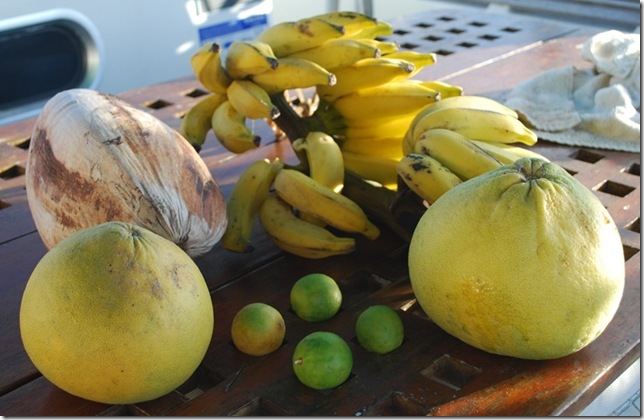 Assorted fruits from Daniel’s Bay
Assorted fruits from Daniel’s Bay
We awoke early on Friday, lifted anchor, and motored out into calm seas. It was a beautiful day, and we took some parting shots of the Marquesas Islands. We hadn’t planned to stay there quite so long (almost a month) but don’t regret a day of it (OK, maybe the day I spent in bed with heat rash). Now it’s only 500 or so miles to the Tuamotu ("many islands" in Tahitian) Archipelago, a group of 76 coral atolls barely above sea level. This would have been our longest passage ever just a few months ago but now seems like a short, pleasant hop. The days are flying by thanks to good books, and the nights have been gorgeous starting with the rising of the orange, nearly-full moon on the horizon around 8:30 p.m..
The big news this morning was that the partial stalk of bananas that we pulled off a tree (from an uninhabited location, mind you) in Taipivai had turned yellow at last. (After a week passed, we were beginning to wonder if they couldn’t ripen off the tree.) They are now almost gone; the little bananas grown here are irresistible.
We are sailing under the main and jib at around 5 knots on average; at this rate, we should arrive at the archipelago on Tuesday. Unlike previous landfalls, we will not be able to see the islands until we are very close. We will then have a somewhat narrow and likely very shallow channel to navigate into a lagoon. We are all excited to experience a new type of island, especially one that will compel us to break out the scuba gear!


